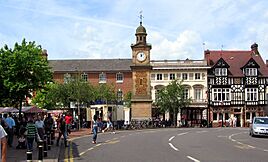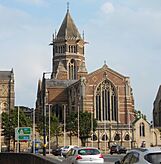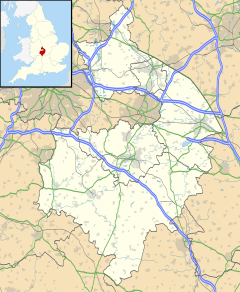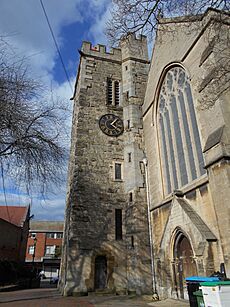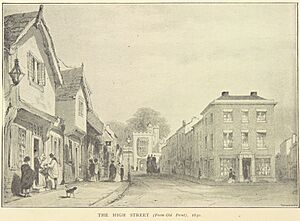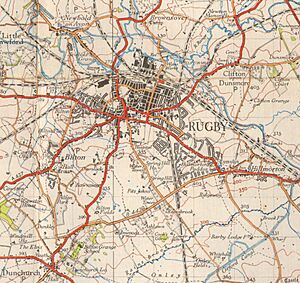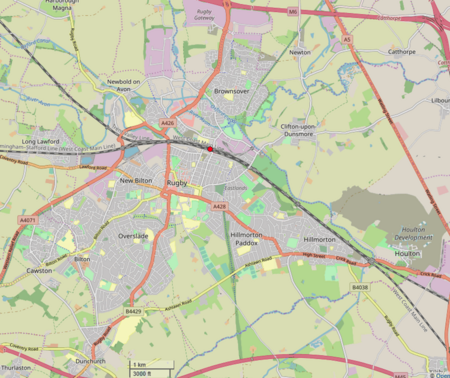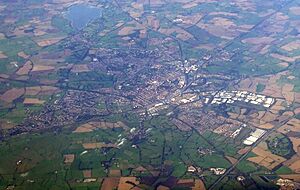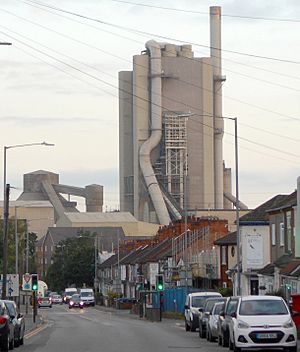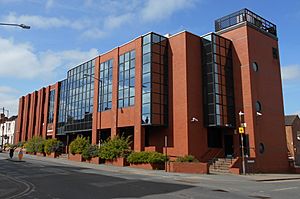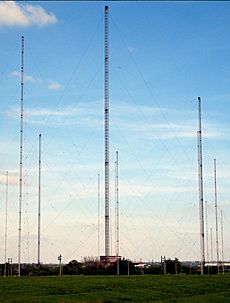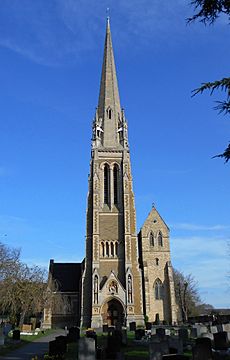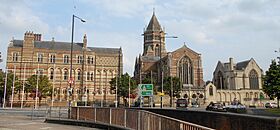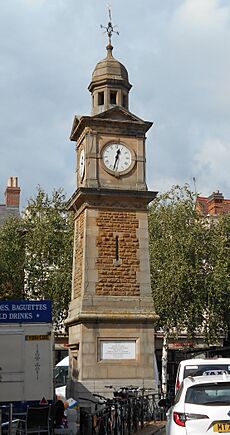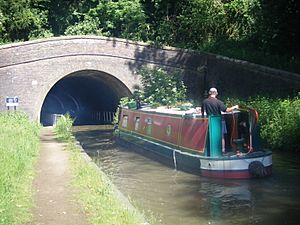Rugby, Warwickshire facts for kids
Quick facts for kids Rugby |
|
|---|---|
| Town | |
|
Clockwise, from top: Rugby market place & Clock Tower, looking west from Church Street; Rugby School Chapel; Rugby Art Gallery, Museum & Library; St Andrew's Church; and William Webb Ellis statue |
|
| Population | 78,117 (2021 census) |
| Demonym | Rugbeian |
| OS grid reference | SP5075 |
| District |
|
| Shire county | |
| Region | |
| Country | England |
| Sovereign state | United Kingdom |
| Post town | RUGBY |
| Postcode district | CV21, CV22, CV23 |
| Dialling code | 01788 |
| Police | Warwickshire |
| Fire | Warwickshire |
| Ambulance | West Midlands |
| EU Parliament | West Midlands |
| UK Parliament |
|
Rugby is a busy market town in eastern Warwickshire, England. It is located close to the River Avon. In 2021, about 78,117 people lived there. This makes Rugby the second-largest town in Warwickshire. The wider area, called the Borough of Rugby, had about 114,400 people in 2021.
Rugby is on the eastern side of Warwickshire. It is near the borders of Leicestershire and Northamptonshire. It is the most easterly town in the West Midlands region. The nearby county lines also mark the edge of the East Midlands region. Rugby is about 83 miles (134 km) north of London. It is 30 miles (48 km) east-south-east of Birmingham.
Rugby became a market town in 1255. Rugby School was started in 1567. It was first a school for local boys. By the 1700s, it became famous across the country. It is known as the place where rugby football was invented. Legend says William Webb Ellis, a schoolboy, invented it in 1823. Rugby was a small town until the mid-1800s. Then, a major railway hub was built there. This helped industries grow and the town's population increase quickly.
Contents
History of Rugby
Early Times in Rugby
Long ago, during the Iron Age, people lived in the Rugby area. The River Avon was a natural border between two tribes, the Dobunni and Corieltauvi. It is thought that protected settlements were built on both sides of the river valley. Rugby was a good spot for a Dobunni watch settlement because it was on a hill overlooking the Avon. Later, during the Roman period, a Roman town called Tripontium was built. It was about 3.4 miles (5.5 km) north-east of today's Rugby, on the Watling Street Roman road. The Romans left Britain, and Tripontium was abandoned.
Medieval Rugby: A Town Begins
The small settlement of Rugby was taken over by the Anglo-Saxons around 560 AD. It was mentioned in the Domesday Book of 1086 as Rocheberie. There are a few ideas about where the name came from. One idea is that it comes from an old Celtic name droche-brig, meaning 'wild hilltop'. Another idea is that Rocheberie was an Old English name Hrocaberg. This meant 'Hroca's hill fortification'. Hroca was an Anglo-Saxon man's name. By the 1200s, the town's name was often spelled Rokeby. It slowly changed to the modern name, Rugby, by the 1700s.
In 1140, St Andrew's Church was first mentioned. It was a small church linked to a bigger one in Clifton-upon-Dunsmore. In 1221, Rugby became its own parish, and the church became a main parish church. In 1255, the local lord, Henry de Rokeby, got permission to hold a weekly market in Rugby. This helped Rugby grow into a small country market town.
In the 1100s, Rugby was said to have a castle where Regent Place is now. We don't know much about this 'castle'. It might have been a fortified manor house. It was likely built during a civil war in the 1100s. It might have been torn down around 1157 by King Henry II. The old earthworks of the castle could still be seen in the 1800s. Some people think the stones from the castle were used to build the west tower of St Andrew's Church. This tower looks like a castle and might have been used for defense.
Rugby in the 1600s
The Rugby area has links to the Gunpowder Plot of 1605. This was a plan to blow up the Houses of Parliament. The plotters stayed at the 'Lion Inn' in nearby Dunchurch. They waited for news from Guy Fawkes. If he had succeeded, they planned to kidnap Princess Elizabeth from Coombe Abbey.
During the English Civil War, a fight happened near Kilsby in 1642. King Charles I passed through Rugby that year. Some of his soldiers stayed in town. However, the people of Rugby supported the Parliamentarians. The soldiers disarmed them. Later, in 1645, Oliver Cromwell and his soldiers stayed in Rugby. This was two months before the big Battle of Naseby.
How Rugby School Changed the Town
Rugby School was started in 1567. It was funded by Lawrence Sheriff, a local man who became rich in London. He wanted it to be a free school for local boys. But by the 1700s, it became a private school where most students paid fees. They came from outside Rugby. The Lawrence Sheriff School was later founded in 1878 to serve local boys as Sheriff had originally planned.
Until the 1800s, Rugby was a small town. Only its school made it well-known. It grew slowly because other nearby towns had better markets. In 1663, Rugby had 160 houses and about 650 people. By 1730, it had 183 houses and about 900 people. Rugby's importance grew faster in the late 1700s and early 1800s. This was because Rugby School became more famous. By 1801, Rugby had 1,487 people and 278 houses. This growth was due to parents moving to Rugby so their sons could attend the school. This also brought more workers and shopkeepers to the town.
The Railway Boom!
Rugby grew into a big town because of the railways. Its location was perfect for different railway lines to meet. By the mid-1800s, the railway junction in Rugby was one of the most important in the country. The first railway arrived in 1838. This was the London and Birmingham Railway (L&BR). In 1840, the Midland Counties Railway joined the L&BR in Rugby. Then, the Trent Valley Railway joined in 1847.
More lines opened in the following years. A line to Peterborough opened in 1850. A line to Leamington opened in 1851. By then, over sixty trains passed through Rugby railway station every day. A line to Northampton opened in 1881. Finally, the Great Central Main Line opened in 1899.
Rugby became a railway town. Many railway workers and their families moved in, and the population grew fast. Rugby's population reached almost 8,000 by 1861. It was nearly 17,000 by 1901. By that time, about one in five people in Rugby worked for the railways.
Industry Grows in Rugby
The railways helped Rugby change from a quiet country area to a big industrial town. In the late 1800s, local industries started to grow. Large-scale cement making began in 1862. The Rugby Lias Lime & Cement Company Ltd used local Blue Lias limestone. A factory making corsets opened in 1882. It employed local women and lasted until 1992, making swimwear by then.
In the 1890s and early 1900s, heavy engineering and electrical companies came to Rugby. They liked its central location and good transport links. This made Rugby a major industrial center. Willans and Robinson arrived in 1897, building steam engines. British Thomson-Houston (BTH) followed in 1902, making electrical motors and generators. Soon, BTH made many types of electrical equipment. Both companies started making turbines in 1904. They were rivals until they both became part of GEC in 1969. Another famous company was Lodge Plugs, which made spark plugs. They opened a factory in 1916.
For most of the 1900s, these engineering factories were the main employers in Rugby. At their peak in the 1960s, BTH alone employed about 22,000 people. Rugby grew quickly in the early 1900s as workers moved in. By the 1940s, Rugby's population was over 40,000. It grew to over 50,000 by the 1960s.
Rugby's Local Government History
Rugby became a local board district in 1849. This was its first modern local government. Before that, it was managed by the church and local lords. The local board's job was to provide things like paved roads, street lights, clean water, and sewers. These districts became urban districts in 1894. Rugby became a municipal borough in 1932. Its borders grew to include nearby villages like Bilton, Hillmorton, Brownsover, and Newbold-on-Avon. These villages became parts of the town. In 1974, the borough joined with the Rugby Rural District to form the current Borough of Rugby.
Modern Rugby: Changes and Growth
After World War II, Rugby became a key point in the motorway network. The M1, M6, and M45 motorways meet near the town. At the same time, the railways became less important, and some lines into Rugby closed. Since the 1980s, the engineering industries have shrunk. Many old factory sites have been turned into homes and shops. Because it is so close to the motorways, Rugby has become a major center for logistics. It is now part of an area called the golden logistics triangle.
In the 2000s, Rugby's urban area has continued to grow. Large new housing areas have been built at Cawston and Houlton. Houlton is on the site of the old Rugby Radio Station to the east of town.
What Rugby is Famous For
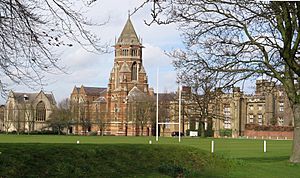
Rugby is most famous for being the birthplace of rugby football. This sport is now played all over the world. The game's invention is often given to William Webb Ellis. He was a student at Rugby School. Legend says he picked up the ball and ran with it during a football match in 1823. Even though there isn't much proof for this story, the school is known for making the sport popular and writing its first rules. In 1845, three Rugby School students wrote the first rules for the "Rugby style of game."
Rugby School is one of England's oldest and most respected private schools. It was the setting for Thomas Hughes's famous book Tom Brown's Schooldays, published in 1857. Hughes later started a colony in America for younger sons of English families. He named the town Rugby. This settlement, Rugby, Tennessee, still exists today.
Rugby School is also said to have inspired the modern Olympic Games. Pierre de Coubertin, a French educator, visited Rugby School in the late 1800s. He said the school was a big reason he decided to bring back the Olympic Games.
Rugby is also where the jet engine was invented. In April 1937, Frank Whittle built and tested the world's first working jet engine. He did this at the British Thomson-Houston (BTH) factory in Rugby. From 1936 to 1941, he worked at Brownsover Hall nearby. He designed and developed early jet engines there. Whittle is remembered in Rugby by a modern statue near the town hall. It was made in 2005 by Stephen Broadbent.
Holography was invented in Rugby in 1947. This was done by Hungarian inventor Dennis Gabor. He was also working at BTH. He later won the Nobel Prize in Physics in 1971 for this invention.
In the 1800s, Rugby became famous for its important railway junction. This junction was the setting for Charles Dickens's story Mugby Junction.
Rugby Today
Today, Rugby is a mix of the original town and older villages. These villages, like Bilton, Hillmorton, Brownsover, and Newbold-on-Avon, became part of Rugby in 1932. Most of them still have their old village centers. Rugby also includes areas like New Bilton, Overslade, Hillside, and the new Houlton housing development. Rugby's growth has almost reached the villages of Clifton-upon-Dunsmore, Cawston, Dunchurch, and Long Lawford.
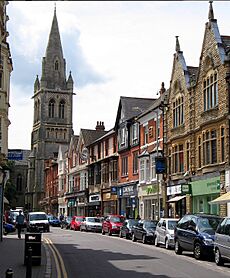
Rugby Town Centre
The town center of Rugby mostly has buildings from the Victorian period and early 1900s. However, some much older buildings still stand, along with newer ones. The main shopping area has always been around the Clock Tower. High Street and Sheep Street, two of these streets, became pedestrian-only in the 1980s.
Until the 1800s, Rugby's main area included only Market Place, High Street, Sheep Street, Church Street, North Street, and what is now Lawrence Sheriff Street. These streets were centered around the Clock Tower. The Clock Tower was built in 1887 where an old cross used to be. These streets still form the heart of the town center. In the Victorian and Edwardian times, more shopping streets were added. These included Albert Street and Regent Street. Regent Street was built in 1905 and was meant to be Rugby's main shopping street, but it never quite became that.
The town center has an indoor shopping mall called Rugby Central Shopping Centre. It opened in 1979. A street market is held in the town center several days a week. In recent years, several large retail parks have opened outside the town. These include Elliott's Field Retail Park and Junction 1 Retail Park.
Geography of Rugby
Most of Rugby is about 400 feet (120 meters) above sea level. It sits on a plateau between river valleys. To the north are the valleys of the River Avon and Swift. To the south are the Rains Brook and River Leam. As Rugby grew, it spread north across the Avon valley. It took in the villages of Brownsover and Newbold, which are north of the Avon valley.
The border between Warwickshire, Northamptonshire, and Leicestershire is to the east of Rugby. This border is marked by the A5 road, which is an old Roman road. The three counties meet at Dow Bridge, where the A5 crosses the River Avon. To the south-east of Rugby, the border with Northamptonshire is the Rains Brook. Rugby is the most easterly town in Warwickshire. It is also the most easterly town in the entire West Midlands region.
- Areas and Districts in Rugby
Suburbs and districts of Rugby include:
- Bilton
- Brownsover
- Hillmorton
- Hillside
- New Bilton
- Newbold-on-Avon
- Overslade
- Rokeby
- Nearby Places
Places next to Rugby, but not part of the town itself:
- Cawston
- Clifton-upon-Dunsmore
- Dunchurch
- Houlton (still being built)
- Long Lawford
- Newton
- Cities and Towns Near Rugby
- Nearby cities: Birmingham, Coventry, and Leicester
- Nearby towns: Bedworth, Daventry, Hinckley, Kenilworth, Leamington Spa, Lutterworth, Northampton, Nuneaton, Southam, and Warwick.
- Villages Near Rugby
- Nearby villages: Barby, Braunston, Brinklow, Catthorpe, Harborough Magna, Kilsby, Lilbourne, Monks Kirby, Newton, and Pailton.
 |
Nuneaton, Bedworth, Hinckley | Leicester, Lutterworth |
Market Harborough, Corby |  |
| Birmingham, Coventry | Kettering, Wellingborough | |||
| Stratford-upon-Avon, Warwick, Leamington Spa | Southam, Banbury |
Daventry, Northampton, London |
Climate in Rugby
Rugby has a typical oceanic climate for inland England. Temperatures are mild for its location. Winter nights usually stay above freezing. Summers can vary a lot depending on wind patterns. The highest temperature ever recorded was 38.7°C (101.7°F). Rainfall is moderate, but it often drizzles. This means there are about 125 days of rain each year.
| Climate data for Church Lawford, 3 miles (5 km) from Rugby (1991–2020 normals), sunshine from Coventry, extremes 1983–present | |||||||||||||
|---|---|---|---|---|---|---|---|---|---|---|---|---|---|
| Month | Jan | Feb | Mar | Apr | May | Jun | Jul | Aug | Sep | Oct | Nov | Dec | Year |
| Record high °C (°F) | 14.7 (58.5) |
17.7 (63.9) |
22.4 (72.3) |
25.5 (77.9) |
27.5 (81.5) |
31.3 (88.3) |
38.7 (101.7) |
34.6 (94.3) |
30.6 (87.1) |
27.6 (81.7) |
18.4 (65.1) |
15.3 (59.5) |
38.7 (101.7) |
| Mean maximum °C (°F) | 12.3 (54.1) |
12.9 (55.2) |
16.1 (61.0) |
20.1 (68.2) |
24.1 (75.4) |
27.0 (80.6) |
29.4 (84.9) |
28.7 (83.7) |
24.4 (75.9) |
19.3 (66.7) |
15.1 (59.2) |
12.9 (55.2) |
30.6 (87.1) |
| Mean daily maximum °C (°F) | 7.1 (44.8) |
7.8 (46.0) |
10.4 (50.7) |
13.6 (56.5) |
16.7 (62.1) |
19.8 (67.6) |
22.3 (72.1) |
21.8 (71.2) |
18.7 (65.7) |
14.3 (57.7) |
10.0 (50.0) |
7.4 (45.3) |
14.2 (57.5) |
| Daily mean °C (°F) | 4.3 (39.7) |
4.7 (40.5) |
6.6 (43.9) |
9.0 (48.2) |
11.9 (53.4) |
14.9 (58.8) |
17.1 (62.8) |
16.9 (62.4) |
14.4 (57.9) |
10.9 (51.6) |
7.1 (44.8) |
4.6 (40.3) |
10.2 (50.4) |
| Mean daily minimum °C (°F) | 1.5 (34.7) |
1.5 (34.7) |
2.7 (36.9) |
4.3 (39.7) |
7.1 (44.8) |
10.0 (50.0) |
11.9 (53.4) |
12.0 (53.6) |
10.0 (50.0) |
7.4 (45.3) |
4.1 (39.4) |
1.8 (35.2) |
6.2 (43.1) |
| Mean minimum °C (°F) | −4.7 (23.5) |
−4.3 (24.3) |
−3.3 (26.1) |
−1.7 (28.9) |
0.3 (32.5) |
4.6 (40.3) |
6.9 (44.4) |
6.6 (43.9) |
4.0 (39.2) |
0.9 (33.6) |
−2.4 (27.7) |
−4.7 (23.5) |
−7.1 (19.2) |
| Record low °C (°F) | −14.5 (5.9) |
−12.2 (10.0) |
−8.5 (16.7) |
−4.9 (23.2) |
−2.2 (28.0) |
−0.2 (31.6) |
3.4 (38.1) |
3.7 (38.7) |
−0.1 (31.8) |
−3.8 (25.2) |
−8.2 (17.2) |
−12.5 (9.5) |
−14.5 (5.9) |
| Average precipitation mm (inches) | 58.0 (2.28) |
44.2 (1.74) |
43.0 (1.69) |
46.5 (1.83) |
55.0 (2.17) |
55.1 (2.17) |
60.0 (2.36) |
67.0 (2.64) |
57.8 (2.28) |
67.4 (2.65) |
63.6 (2.50) |
59.6 (2.35) |
677.2 (26.66) |
| Average precipitation days (≥ 1.0 mm) | 12.0 | 10.1 | 10.2 | 9.9 | 9.9 | 9.2 | 9.0 | 9.7 | 9.6 | 10.7 | 12.2 | 12.0 | 124.5 |
| Mean monthly sunshine hours | 55 | 75 | 115 | 147 | 192 | 185 | 198 | 180 | 137 | 101 | 63 | 61 | 1,509 |
| Source 1: Met Office | |||||||||||||
| Source 2: Infoclimat | |||||||||||||
People of Rugby
In the 2021 census, Rugby had 78,125 residents. This was more than the 70,628 people in 2011. It was also more than the 62,580 people in 2001.
In 2021, here's a look at the different groups of people in Rugby:
- 84.3% of Rugby residents were White.
- 8.3% were Asian.
- 3.1% were Black.
- 3.0% were Mixed.
- 1.1% were from other ethnic groups.
When it comes to religion, 52.9% of Rugby residents said they were Christian. 38.6% said they had no religion. 4.0% were Hindu. 2.3% were Muslim. 1.2% were Sikh. 0.4% were Buddhists. And 0.6% were from another religion.
Fun Things to Do in Rugby
The biggest place for events in Rugby is the Benn Hall. It opened in 1961. Rugby has two theatres. One is the professional Macready Theatre. The other is the amateur Rugby Theatre. Both are in the town center. There is also a nine-screen cinema run by Cineworld. It is located at a retail park north of the town center.

The Rugby Art Gallery, Museum and Library opened in 2000. It hosts different art shows. It has a famous collection of 20th Century and British Art. This includes 170 artworks by artists like L. S. Lowry and Paula Rego. The museum also shows Roman items found from the nearby town of Tripontium. It also has exhibits about Rugby's social history. The town's library is also in this building.
The Webb Ellis Rugby Football Museum is also in the town center. It has many items related to rugby.
The famous poet Rupert Brooke was born and grew up in Rugby. There is a statue of him in Regent Place.
In the 1960s, Clifton Hall in Rugby was a center for rock music. Many bands, like The Fortunes, started their careers there. In the 1980s, the band Spacemen 3 was formed in Rugby. After it ended in 1991, the musicians went on to form other successful bands. Other famous musicians from Rugby include James Morrison and Emily Burns.
Rugby has two large urban parks in the town center. One is Caldecott Park next to the town hall. The other is the Whitehall Recreation Ground.
Rugby has an indoor leisure centre called the Queen's Diamond Jubilee Centre. It opened in 2013. It is run by GLL, a charity, for the local council.
Sports in Rugby

- Rugby has several rugby union teams. These include the Rugby Lions, Rugby Welsh, and Rugby St. Andrews RFC.
- Rugby has two non-league football clubs. These are Rugby Town F.C. and Rugby Borough F.C..
- There are two golf courses near the town.
- The Rugby Lawn Tennis Club is one of the oldest in the world. It was started in 1876.
- Rugby's Artistic Swimming Club competes at regional and national levels.
Rugby's Economy
For most of the 1900s, manufacturing was the biggest employer in Rugby. This peaked in the 1950s. Since then, it has slowly declined. Now, service industries provide the most jobs.
In 2017, the average yearly wage in the Rugby borough was £29,059. This was higher than the average for Warwickshire and the UK.
Engineering and Manufacturing
Rugby is still an engineering center. It has a long history of making gas and steam turbines and electrical equipment. Many different companies have done engineering in Rugby. It started in the 1900s with British Thomson-Houston (BTH) and Willans & Robinson. These later became part of General Electric Company (GEC) and then Alstom. Much of the engineering work used to be north of the railway station. Since the 1980s, many of these factories have closed. Their land has been used for homes and shops. However, engineering still happens in Rugby on a smaller scale. GE Power Conversion makes large electric motors and services steam turbines.
Further away, in the Rugby borough, is the Rolls-Royce engineering factory near Ansty. This is closer to Coventry than Rugby.
Rugby is also a center for making lasers. This started with JK Lasers in 1972. In 1982, JK Lasers joined with Lumonics of Canada. For a time, it was one of the biggest industrial laser companies. Now, it is part of SPI Lasers, owned by the Trumpf company. In 2018, SPI Lasers said their Rugby factory would double in size. Another laser company in Rugby is Litron Lasers, started in 1997.
Cement Production
Another big industry in Rugby is cement making. This started small in the early 1800s. It became large-scale in the 1860s when the Rugby Cement company was founded. They made cement from local Jurassic Blue Lias limestone at New Bilton. The current cement works in Rugby has the largest cement kiln in the UK. It can make 1.8 million tonnes of cement a year. The current factory opened in 2000. It was rebuilt and made much bigger in the late 1990s. Rugby Cement was taken over in 2000. It is now owned by the Mexican company Cemex. Cemex moved its UK headquarters to Rugby in 2018.
Logistics and Transport
Rugby is often called part of the golden logistics triangle. This is because of its central location and good transport links. In 2021, Rugby had the highest percentage of businesses used for transport and storage in the UK, at 17%. Since the 1980s, many large industrial estates have been built north of the town. Warehousing, distribution, and light industry have become major employers. This is because the town is very close to the M6 motorway (Junction 1) and M1 (Junction 19). These are at the heart of the UK's motorway network. In 2017, almost half of Warwickshire's transport and storage businesses were in Rugby. In 2017, Hermes opened its 'Midlands Super Hub' parcel delivery center in Rugby. It is the largest of its kind in the UK. To the east of Rugby is the large Daventry International Rail Freight Terminal (DIRFT). This opened in the 1990s. Even though it is in Northamptonshire, it is closest to Rugby.
Companies and Groups in Rugby
The American fashion company Gap Inc. has its UK headquarters and distribution center in Rugby since 2002. The construction company Morgan Sindall and the legal firm Brethertons are also based here. Many trade, professional, and charity groups also have their main offices in Rugby. These include the Institution of Chemical Engineers, the Institution of Lighting Professionals, and Practical Action.
Tourism and Other Industries
Tourism is also important to Rugby's economy. This is especially true for things related to Rugby football.
One of the last links to Rugby's farming past was the cattle market. It was held near the railway station. Before that, it was in the "Market Place" in the old town center. This market closed in late 2008. The site has been redeveloped into homes, a hotel, and a Tesco store.
Famous Buildings and Places
One of the most famous landmarks near Rugby was the Rugby Radio Station. It was a huge radio transmitting station just east of the town. It opened in 1926. In the 1950s, it was the largest radio station in the world. It had 57 radio transmitters and covered 1600 acres. Its use slowly decreased from the 1980s. The station closed between 2003 and 2007. Several masts were taken down with explosives in 2004. The last four very tall masts were taken down on August 2, 2007. The site is now being developed into a new housing area called Houlton.
The Rugby Cement works is west of the town. The main tower of the cement works is 400 feet (120 meters) tall. It can be seen from far away. This landmark is sometimes debated. In 2005, it was in the top ten of a poll of buildings people wanted to see demolished. In October 2006, the owners, Cemex, were fined £400,000 for too much pollution.
The town has statues of three famous local people: Rupert Brooke, Thomas Hughes, and William Webb Ellis. The Rupert Brooke statue is in Regent Street. It honors his poetry. Thomas Hughes' statue is in the gardens of the Temple Reading Rooms. Since England won the Rugby World Cup in 2003, the William Webb Ellis statue outside Rugby School has become very popular.
Rugby grew a lot in the 1800s. So, the central area of Rugby has many beautiful examples of Victorian architecture. These include:
St Andrew's Church is in the town center. It is Rugby's main Church of England parish church. A church has been on this spot since 1140. The oldest part is the 22-meter (72 ft) high west tower. It looks a lot like a castle turret. This tower was likely built in the 1200s. It might have been used for defense as well as religion. It is Rugby's oldest building. The church also has a 13th-century chest and a medieval font. The church was greatly rebuilt and made bigger in the 1800s. A new east tower with a 182-foot (55 m) high spire was added in 1895. The church is a grade II* listed building. Both church towers have bells that can be rung.
St Marie's Church on Dunchurch Road is Rugby's main Roman Catholic church. It is one of the town's most famous landmarks because it stands out in the skyline. The church first opened in 1847. It was designed by Pugin in the Gothic revival style. It was made bigger in 1864. In 1872, the tall, thin spire was added. It is nearly 200 feet (61 m) tall. This church is also grade II* listed.
The buildings of Rugby School are major landmarks. Most of them are from the 1700s and 1800s, with some additions from the early 1900s. The oldest parts are the Old Quad Buildings and the School House, dating from 1748. Many of the famous buildings were designed by William Butterfield. The most notable is the chapel, built in 1872. It has an octagonal tower 138 feet (42 m) tall. This chapel is a grade I listed building.
There are two other grade I listed buildings in Rugby. These are St Botolph's Church in Newbold-on-Avon and Bilton Hall in Bilton.
Rugby's Jubilee Clock Tower in Market Place is one of the town's best-known landmarks. It traditionally marks the center of Rugby. The clock tower was built in 1887 to celebrate Queen Victoria's jubilee. It is 43 feet (13 m) tall and made of Derby Dale stone. It is a grade II listed building.
Places to Visit
Places of interest in the town include:
- The Rugby School Museum. It has displays about the history of Rugby School and the town.
- The combined Rugby Art Gallery and Museum. The art gallery has a famous collection of modern art. The museum has Roman items found from the nearby Roman settlement of Tripontium.
- The Webb Ellis Rugby Football Museum. Here, traditional rugby balls are handmade. It has many rugby football items.
- The Benn Hall, a place for conferences, shows, and parties.
- Newbold Quarry Park, a nature reserve.
- Swift Valley Nature Reserve.
- Rainsbrook Valley Railway, a miniature railway.
Places of interest around Rugby include:
- Brandon Marsh.
- Brinklow Castle.
- Coombe Abbey.
- Dunchurch – a historic village.
- Draycote Water – a reservoir and nature reserve.
- Garden Organic.
- Oxford Canal.
- Stanford Hall.
Getting Around Rugby
Trains
Rugby railway station is a main stop on the West Coast Main Line. Many trains go to London Euston, Birmingham New Street, Stafford, Crewe, and Northampton. Some trains also go to Glasgow Central, the North West of England, Shrewsbury, Chester, and Holyhead. These routes are run by West Midlands Trains and Avanti West Coast.
Rugby has had a railway station since 1838. The current station was built in 1885. It used to have more lines, like to Leicester and Leamington Spa. These closed in the 1960s.
Between 1899 and 1969, Rugby had a second station called Rugby Central station. It was on the old Great Central Main Line. This line went to London Marylebone and to Leicester and Nottingham. This station and line also closed in the 1960s.
British Railways had a locomotive testing center in Rugby.
Warwickshire County Council has suggested a new station called Rugby Parkway station. It would be on the Northampton Loop Line. It would serve the Hillmorton area and the new Houlton development. This station would help with the town's future growth.
Roads
Rugby is near several major roads. These include the M1, M6, and M45 motorway motorways. Also nearby are the A5, A14, and A45 road roads. Other main roads in town are the A426 road, the A428 road, and the Rugby Western Relief Road. This relief road connects the A45 with the Leicester Road, which leads to junction 1 of the M6.
In 2010, a short local bypass opened. It was the first part of the Rugby Western Relief Road. This road helps heavy traffic avoid residential streets. The final part of Rugby's Western Relief Road opened on September 10, 2010. The road runs from Potsford Dam near Cawston to Newbold Road.
Buses
Stagecoach in Warwickshire is the main bus company in Rugby. It has routes to Coventry, Southam, Leamington Spa, Daventry, Leicester, and Northampton. It also serves the main areas of the town.
Air Travel
There are direct train links to Birmingham Airport. The smaller Coventry Airport is also nearby.
Canal
The Oxford Canal runs from near Coventry to Oxford. It passes around Rugby and through the areas of Newbold, Brownsover, and Hillmorton. The canal opened in 1790. It was straightened in the 1830s. Important features of the canal here are the 250-yard (229 m) long tunnel at Newbold. Also, the locks at Hillmorton are the busiest on the national canal network.
Cycling
Rugby has many cycling routes. Some are cycle lanes next to roads. Others are off-road and traffic-free. Some of these use old railway paths.
Famous People from Rugby
Born in Rugby
- Chris Adams (1955–2001), wrestler
- Neil Adams (born 1958), judoka
- Junade Ali (born 1996), computer scientist
- Melanie Astles, (born 1982) French aerobatic champion
- David Barby (1943–2012), antiques expert
- Ian Bell (born 1982), cricketer
- Laura Bettinson (born 1987), singer-songwriter
- Andrew Bloxam (1801–1878), clergyman and naturalist
- Matthew Bloxam (1805–1888), antiquarian and archaeologist
- Arthur Bostrom (born 1955), actor, known for his role as Officer Crabtree in 'Allo 'Allo!
- Rupert Brooke (1887–1915), poet
- Richard Cockerill (born 1970), rugby union coach and former player
- Ben "Yahtzee" Croshaw (born 1983), comedic writer
- Jim Dewes (born 1957), cricketer
- Maud Russell England (1863–1956), New Zealand teacher and art dealer
- Walter Gilbert (1871–1946), sculptor
- Herbert Haddock (1861–1946), ship captain, the first person to captain Titanic
- Michael John Harrison (born 1945), writer
- Ali James (born 1979), rugby player
- Peter Kember (born 1965), musician (Spacemen 3, Spectrum)
- Jeremy R. Knowles (1935–2007), chemist
- Richard Lindon (1816–1887), leatherworker, inventor
- Norman Lockyer (1836–1920), scientist, discovered the gas helium
- Rose Macaulay (1881–1958), writer
- Ray Mawby (1922–1990) - Conservative politician
- Katharine Merry (born 1974), former sprinter
- James Morrison (born 1984), singer-songwriter
- James Petiver (1665–1718), botanist
- Jason Pierce (born 1965), musician (Spiritualized, Spacemen 3)
- Tim Pigott-Smith (1946–2017), actor
- Marjorie Pollard (1899–1982), field hockey and cricket player, film maker and writer
- Carole Quinton (born 1936) former track and field athlete
- Peter Rogers (1947-2020), businessman
- Sam Ruddock (born 1990), track and field athlete
- Lawrence Sheriff (c. 1510–1567), grocer, philanthropist
- Barbara Stocking (born 1951), public servant
- Vikki Stone, (born 1985), comedienne
- Lauren Taylor (born 1994), golfer
- Chris Wakelin (born 1992), snooker player
- Peter Whalley (1722–1791), clergyman, academic and schoolmaster
- Mona Wilson (1872–1954), civil servant and author
- Arnold Wolfendale (1927–2020), Astronomer Royal
- Kimberley Woods (born 1995), Canoeist
- Albert Wratislaw (1822–1892), clergyman and scholar
Lived or Lives in Rugby
- Joseph Addison (1672-1719), writer and politician
- Matthew Arnold (1822–1888), poet
- Thomas Arnold (1795–1842), educator
- Emily Burns (born 1994), singer-songwriter
- Lewis Carroll (1832–1898), writer
- Will Carruthers (born 1967), musician
- Neville Chamberlain (1869–1940), politician
- Paul Dirac (1902-1984), physicist
- William Webb Ellis (1806–1872), clergyman, claimed inventor of rugby football
- Reginald Foort (1893–1980), organist
- Dennis Gabor (1900–1979), physicist
- William Gilbert (1799–1877) established Gilbert company sports equipment manufacturer.
- Thomas Hughes (1822–1896), writer
- Billy J. Kramer (born 1943), singer
- Unity Mitford (1914–1948), socialite
- John Moultrie (1799–1874), clergyman and poet
- Kevin Painter (born 1967), darts player
- Peter Purves (born 1939), television presenter
- Yvonne Ruddock (1965-1981), victim of the New Cross house fire in London.
- Salman Rushdie (born 1947), novelist
- Judy Simpson (born 1960), athlete
- Lesley Souter (1917–1981) first female electrical engineering student at the University of Glasgow
- Franco Wanyama (1968–2019), boxer
- Frank Whittle (1907–1996), inventor
- Clem Wilson (1875–1944), cricketer
- Johnny Williams (1926–2007), boxer
- Richard Henry Wood (1820–1908), antiquary and philanthropist
Education in Rugby
Primary Schools
- State Schools
- Abbots Farm Junior School
- Abbots Farm Infant School
- Bawnmore Infant School
- Bilton Infant School
- Bilton CE Junior School
- Boughton Leigh Infant
- Boughton Leigh Junior
- Brownsover Community Infant School
- Cawston Grange Primary School
- Clifton-upon-Dunsmore Primary School
- Eastlands Primary School
- English Martyrs Catholic Primary School
- Henry Hinde Infant School
- Henry Hinde Junior School
- Hillmorton Primary School
- Northlands Primary School
- Oakfield Primary Academy
- Paddox Primary School
- Riverside Academy
- Rokeby Infant School
- Rokeby Junior School
- Rugby Free Primary School
- St Andrew's Benn CE Primary School
- St Gabriels's CofE Academy
- St Maries RC Infant School
- St Maries RC Junior School
- St Matthews Bloxham CE Primary School
- Independent Schools
- Crescent School
Secondary Schools
- Comprehensive Schools
- Avon Valley School
- Bilton School
- Harris Church of England Academy
- Houlton School
- Rugby Free Secondary School
- Partially Selective Schools
- Ashlawn School
- Grammar Schools
- Lawrence Sheriff School
- Rugby High School for Girls
- Independent Schools
- Rugby School
- Bilton Grange
Further Education
- Rugby College – part of the Warwickshire College Group.
- Percival Guildhouse - an independent adult education charity.
Local News and Media
Local radio stations include BBC CWR, Hits Radio Coventry & Warwickshire, and Capital Mid-Counties.
The main local newspapers are the Rugby Advertiser, Rugby Observer, and Warwickshire Telegraph. The Warwickshire Telegraph is a local version of the Coventry Telegraph.
Regional TV News for the Rugby area is covered by BBC Midlands Today and ITV News Central.
Twin Towns
Rugby is twinned with:
- Évreux, France (since 1959)
- Rüsselsheim, Germany (since 1977)
Images for kids
-
Rupert Brooke, poet
-
Norman Lockyer, scientist, discovered helium
-
Barbara Stocking, former head of Oxfam GB
See also
 In Spanish: Rugby (Warwickshire) para niños
In Spanish: Rugby (Warwickshire) para niños


